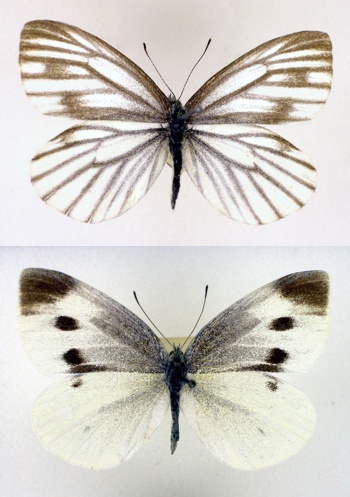Pests
Pieris napi (L.) - Green-veined White, Mustard White
Systematic position.
Class Insecta, order Lepidoptera, superfamily Papilionoidea, family Pieridae, subfamily Pierinae, genus Pieris. The species area in the territory of the USSR is shown for all subspecies (5 to 7) and forms with uncertain taxonomic position.Synonyms.
Artogeia napi (L.).Biological group.
Pest of vegetable cultures.Morphology and biology.
Wingspan is 18-25 mm. Male forewings are white from above, with black or gray apex, often with rounded black spot at mediocubital cell. Pretornal area and costal margin darkened; veins gray pollinose at margins. Hindwings white, with darkened base; pattern of lower surface is visible from above. The lower surface of forewings white, with greenish or ocher-yellow spot at apex; veins gray pollinose along whole length. The lower surface of hindwings are greenish or ocher-yellow; veins widely gray limbate; costal margin orange at base. Female forewings have additional black spots. Egg is bottle-shaped, ribbed, yellowish-white to light green, with 14 costulae, 1 mm thick. Caterpillar (30 mm in length) dark green dorsally, yellowish-green ventrally, with small black dots and albescent warts, sometimes with yellow lateral longitudinal stripe. Pupa green, with yellowish costulae, more slender and less angular than that of P. rapae, with black spots. Pupae overwinter.Distribution.
Trans-Holarctic species. It is distributed in Europe, North America, in mountains of North Africa (locally), Minor and Central Asia, in Northeast China, Korea, Japan; in Baltic States, Byelorussia, Moldova, Ukraine, the Caucasus, Transcaucasia, in mountain areas of Middle Asia and Kazakhstan (except for high mountains), in Northern Kazakhstan. In Russia, it is distributed everywhere (except for tundra and mountain tundra; being a migrant species in forest-tundra); i.e., in the European part (except for extreme southeast), the Urals, Siberia, the Far East (including Sakhalin, Kamchatka, Magadan Regions, and Kurile Islands).Ecology.
The species has 3 generations in the South, 2 generations northward, being monovoltine in the north of its area. Imagoes of the wintering generation fly beginning in March in southern regions, May - June in middle strip and Siberia; summer butterflies fly in the beginning of July into August; those of the third generation fly in September. Butterflies fly until October. They prefer open places (meadows, steppes, glades, clearings, etc.). In mountains, they have been marked at 2400-2800 m above sea level. Caterpillars feed on cultural and wild-growing crucifers and legumes; they have been marked on geranium, dandelions, mignonette, and willow.Economic significance.
This is a minor pest of cabbage, turnip, swede, garden radish, radish, rape, mustard, saffron milk cap, etc. Caterpillars gnaw out holes in leaves or eat them around to skeletal veins. Control measures are as follows: Agronomical include correct crop rotation, removal of vegetation residues from fields, and deep autumn plowings. Chemical measure is insecticide treatments in the period of caterpillar hatching.Reference citations:
Chernov Yu.I. & Tatarinov A.G. 2006. Rhopalocera (Lepidoptera) in fauna of Arctic regions. Zoologicheskii zhurnal 85(10): 1205-1229 (in Russian).Dubatolov V.V., Strel.tsov A.N. & Sergeev M.G. 2005. Family Pieridae. In: Ler P.A., ed. Keys to insects of the Far East of the USSR. V. 5. Trichoptera and Lepidoptera. Part 5. Vladivostok: Dal.nauka, p. 207-234 (in Russian).
Ermolenko V.M. 1984. Atlas of insect pests of field crops. Kiev: Urozhai, 128 p. (in Ukrainian).
Korshunov Yu.P. 2002. Ropalocerous Lepidoptrans of northern Asia. Moscow: KMK, 424 p. (in Russian).
Kurentsov A.I. 1970. Keys to Rhopalocera of the Far East of the USSR. Leningrad: Nauka, 164 p. (in Russian).
L.vovskii A.L. 1999. Pieridae. In: Kuznetsov V.I., ed. Insects and mites . pests of agricultural plants. V. 3(2). Lepidoptera. St.Petersburg: Nauka: 233-242. (in Russian).
Nekrutenko Yu.P. 1974. Pieridae. In: Vasil.ev V.P., ed. Pests of agricultural crops and forest plantations. V.2. Arthropods. Kiev: Urozhai: 411-414 (in Russian).
Nekrutenko Yu.P. 1985. Keys to Rhopalocera of the Crimea. Kiev: Naukova dumka, 151 p. (in Russian).
Yakhontov V.V. 1953. Pests of agricultural plants and products of Central Asia and their control. Tashkent: State Publishing House UzSSR, 663 p. (in Russian).
Znamenskaya M.K. 1962. Review of pests of agricultural plants of Murmansk Region. Entomologicheskoe obozrenie 41(2): 310-322 (in Russian).


